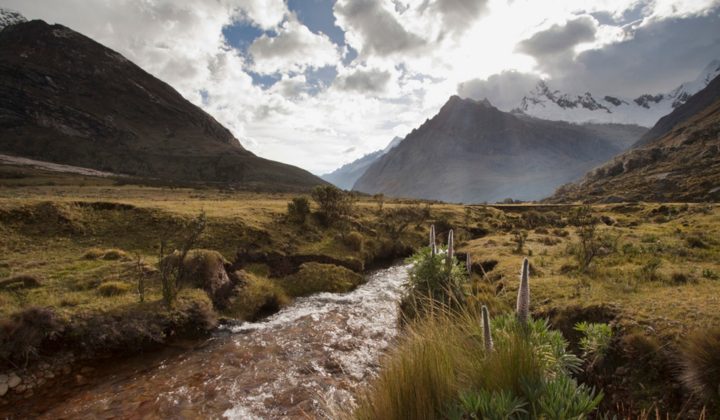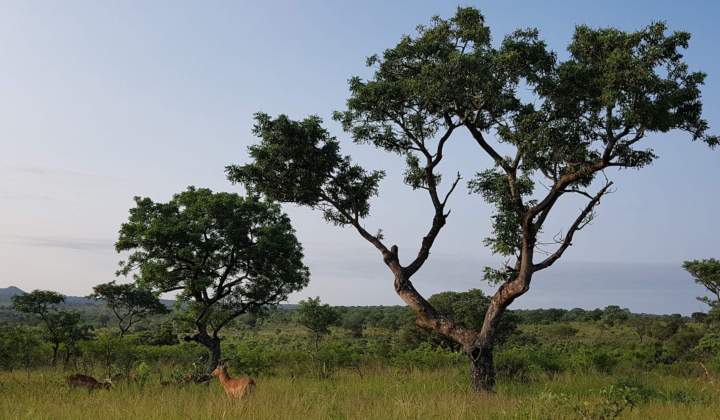Impacts of future climate change on Biodiversity and Ecosystems
Ito, A., C. P. O. Reyer, A. Gadeke, P. Ciais, J. F. Chang, M. Chen, L. Francois, M. Forrest, T. Hickler, S. Ostberg, H. Shi, W. Thiery, and H. Q. Tian. 2020. Pronounced and unavoidable impacts of low-end global warming on northern high-latitude land ecosystems. Environmental Research Letters 15:11. doi: 10.1088/1748-9326/ab702b.
Takolander, A., T. Hickler, L. Meller, and M. Cabeza. 2019. Comparing future shifts in tree species distributions across Europe projected by statistical and dynamic process-based models. Regional Environmental Change 19:251-266. doi: 10.1007/s10113-018-1403-x
Baumbach, L., A. Niamir, T. Hickler, and R. Yousefpour. 2019. Regional adaptation of European beech (Fagus sylvatica) to drought in Central European conditions considering environmental suitability and economic implications. Regional Environmental Change 19:1159-1174. doi: 10.1007/s10113-019-01472-0.
Hof, C., A. Voskamp, M. F. Biber, K. Bohning-Gaese, E. K. Engelhardt, A. Niamir, S. G. Willis, and T. Hickler. 2018. Bioenergy cropland expansion may offset positive effects of climate change mitigation for global vertebrate diversity. Proceedings of the National Academy of Sciences of the United States of America 115:13294-13299. doi: 10.1073/pnas.1807745115.
Fire in the Earth System
Lasslop, G., S. Hantson, S. P. Harrison, D. Bachelet, C. Burton, M. Forkel, M. Forrest, F. Li, J. R. Melton, C. Yue, S. Archibald, S. Scheiter, A. Arneth, T. Hickler, and S. Sitch. 2020. Global ecosystems and fire: Multi-model assessment of fire-induced tree-cover and carbon storage reduction. Global Change Biology:15. doi: 10.1111/gcb.15160.
Teckentrup L, Harrison SP, Hantson S, Heil A, Melton JR, Forrest M, Li F, Yue C, Arneth A, Hickler T, Sitch S, Lasslop G. 2019. Response of simulated burned area to historical changes in environmental and anthropogenic factors: a comparison of seven fire models. Biogeosciences 16: 3883–3910 doi: 10.5194/bg-16-3883-2019.
Andela N, Morton DC, Giglio L, Chen Y, Werf GR van der, Kasibhatla PS, DeFries RS, Collatz GJ, Hantson S, Kloster S, Bachelet D, Forrest M, Lasslop G, Li F, Mangeon S, Melton JR, Yue C, Randerson JT. 2017. A human-driven decline in global burned area. Science 356: 1356–1362 doi: 10.1126/science.aal4108.
Hantson S, Arneth A, Harrison SP, Kelley DI, Prentice IC, Rabin SS, Archibald S, Mouillot F, Arnold SR, Artaxo P, Bachelet D, Ciais P, Forrest M, Friedlingstein P, Hickler T, Kaplan JO, Kloster S, Knorr W, Lasslop G, Li F, Mangeon S, Melton JR, Meyn A, Sitch S, Spessa A, van der Werf GR, Voulgarakis A, Yue C. 2016. The status and challenge of global fire modelling. Biogeosciences 13: 3359–3375 doi: 10.5194/bg-13-3359-2016.
Paleo-environmental Changes
Allen, J. R. M., Forrest, M., Hickler, T., Singarayer, J. S., Valdes, P. J., & Huntley, B. 2020. Global vegetation patterns of the past 140,000 years. Journal of Biogeography, 18, doi: 10.1111/jbi.13930.
Feurdean A, …, Warren D,… , Forrest M, Liakka J,. .., Werner C, …, Naimar A , …, Pfeiffer M, … Hickler T. 2020. Fire hazard modulation by long-term dynamics in land cover and dominant forest type in eastern and central Europe. Biogeosciences 17: 1213–1230. doi: 10.5194/bg-17-1213-2020.
Ecological and Ecosystem Modelling
Forrest M, Tost H, Lelieveld J, Hickler T. 2020. Including vegetation dynamics in an atmospheric chemistry-enabled general circulation model: linking LPJ-GUESS (v4.0) with the EMAC modelling system (v2.53). Geoscientific Model Development 13: 1285–1309 doi: 10.5194/gmd-13-1285-2020.
Dantas de Paula, M, Gómez Giménez M, Niamir A, Thurner M, and Hickler, T. 2020. Combining European Earth Observation products with Dynamic Global Vegetation Models for estimating Essential Biodiversity Variables. International Journal of Digital Earth 13:2 262-277 doi: 10.1080/17538947.2019.1597187.
Dantas de Paula M, Groeneveld J, Fischer R, Taubert F, Martins V F, and Huth A. 2018. Defaunation impacts on seed survival and its effect on the biomass of future tropical forests. OIKOS 00: 1-13 doi: 10.1111/oik.05084
Bagnara ,M, Silveyra Gonzalez R, Reifenberg S, Steinkamp J, Hickler T, Werner C, Dormann CF, and Hartig ,F. 2019. An R package facilitating sensitivity analysis, calibration and forward simulations with the LPJ-GUESS dynamic vegetation model. Environmental Modelling and Software 111: 55–60 doi: 10.1016/j.envsoft.2018.09.004
Invasive Species
Seebens, H; Bacher, S; Blackburn, T. 2020. Projecting the continental accumulation of alien species through to 2050. Global Change Biology (In press).
Seebens H, Blackburn TM, Dyer EE, Genovesi P, Hulme PE, Jeschke JM, Pagad S, Pyšek P, van Kleunen M, Winter M, Ansong M, Arianoutsou M, Bacher S, Blasius B, Brockerhoff EG, Brundu G, Capinha C, Causton CE, Celesti-Grapow L, Dawson W, Dullinger S, Economo EP, Fuentes N, Guénard B, Jäger H, Kartesz J, Kenis M, Kühn I, Lenzner B, Liebhold AM, Mosena A, Moser D, Nentwig W, Nishino M, Pearman D, Pergl J, Rabitsch W, Rojas-Sandoval J, Roques A, Rorke S, Rossinelli S, Roy HE, Scalera R, Schindler S, Štajerová K, Tokarska-Guzik B, Walker K, Ward DF, Yamanaka T, Essl F. 2018. Global rise in emerging alien species results from increased accessibility of new source pools. Proceedings of the National Academy of Sciences 115: E2264–E2273, doi: 10.1073/pnas.1719429115.
Seebens H, Blackburn TM, Dyer EE, Genovesi P, Hulme PE, Jeschke JM, Pagad S, Pyšek P, Winter M, Arianoutsou M, Bacher S, Blasius B, Brundu G, Capinha C, Celesti-Grapow L, Dawson W, Dullinger S, Fuentes N, Jäger H, Kartesz J, Kenis M, Kreft H, Kühn I, Lenzner B, Liebhold A, Mosena A, Moser D, Nishino M, Pearman D, Pergl J, Rabitsch W, Rojas-Sandoval J, Roques A, Rorke S, Rossinelli S, Roy HE, Scalera R, Schindler S, Štajerová K, Tokarska-Guzik B, van Kleunen M, Walker K, Weigelt P, Yamanaka T, Essl F. 2017. No saturation in the accumulation of alien species worldwide. Nature Communications 8: 14435, doi:10.1038/ncomms14435.



